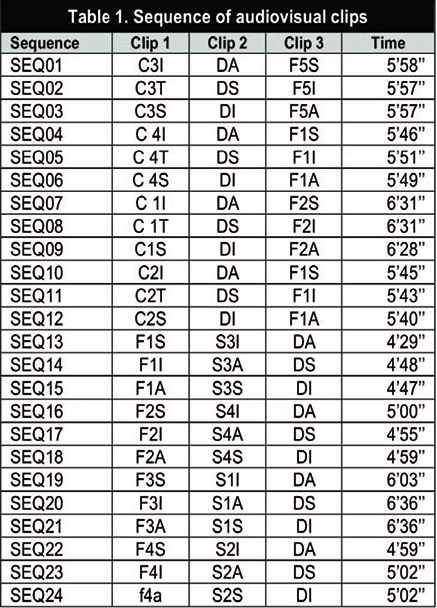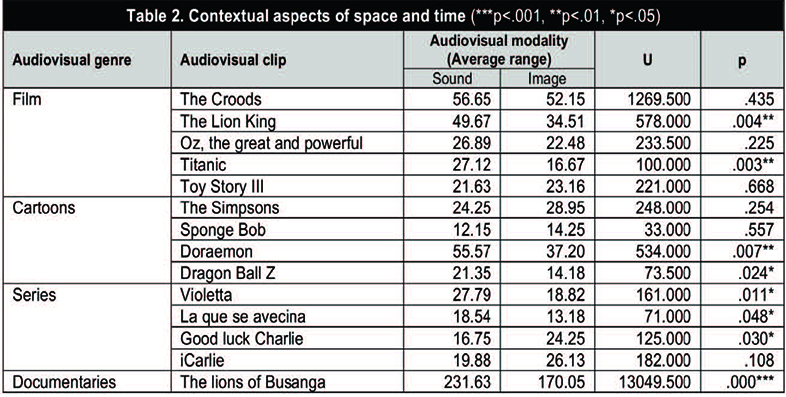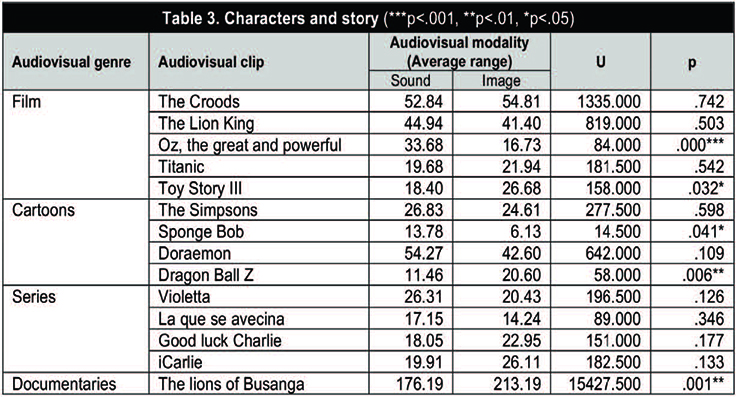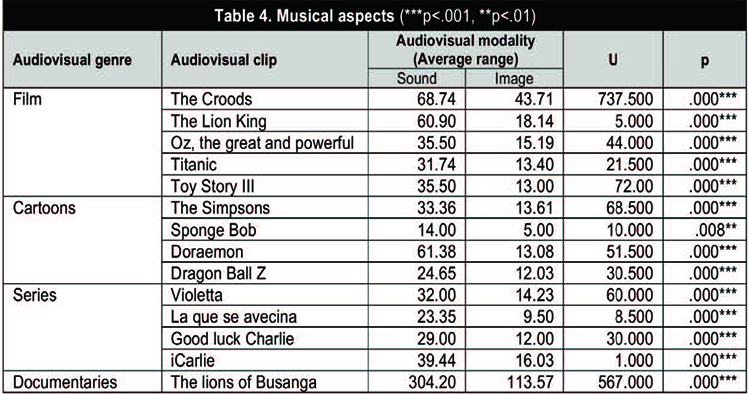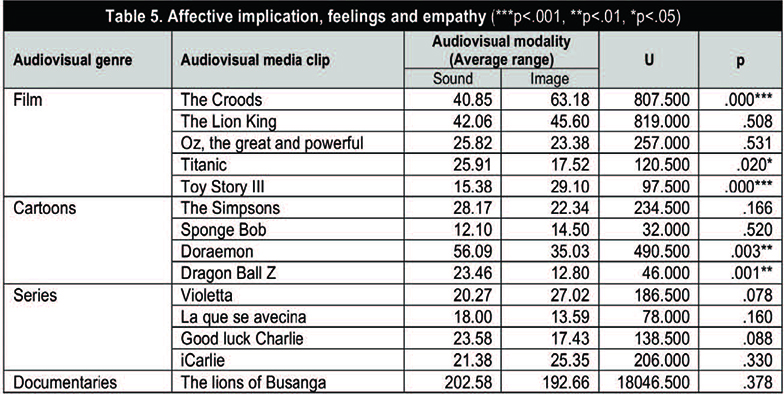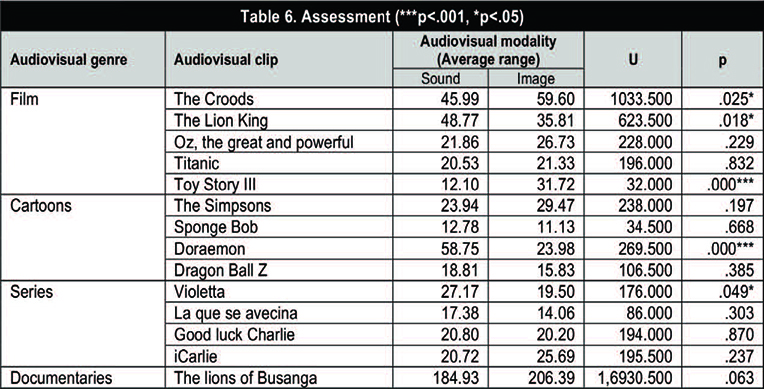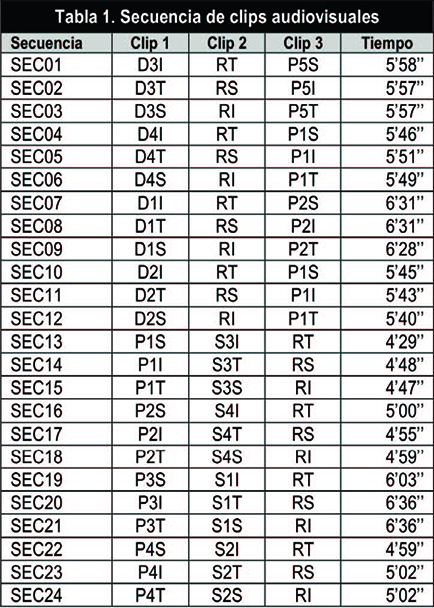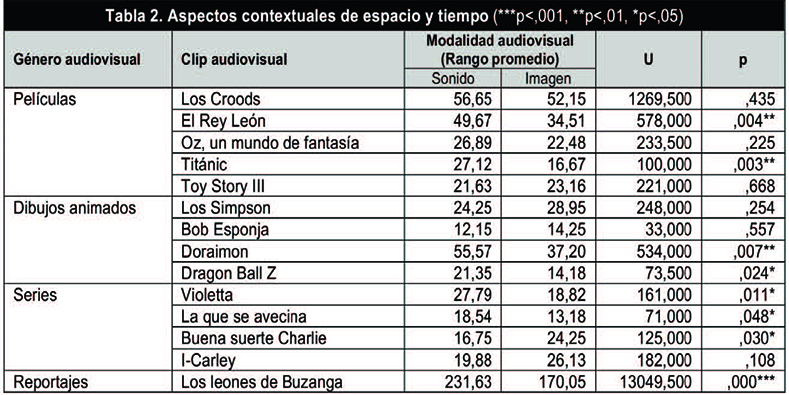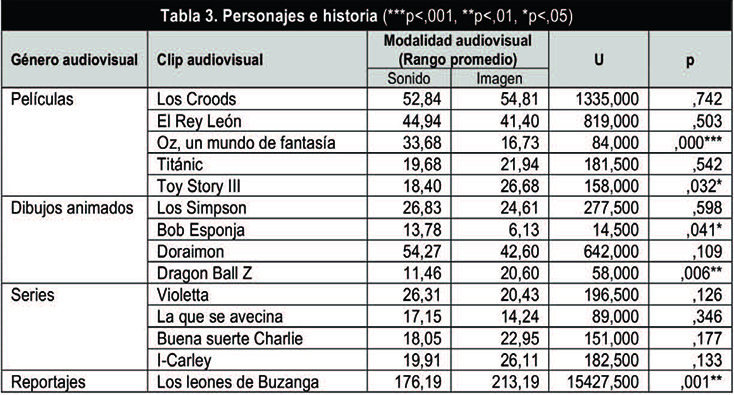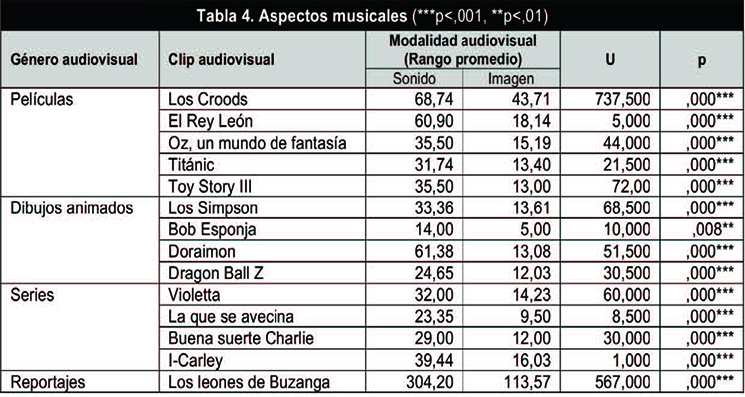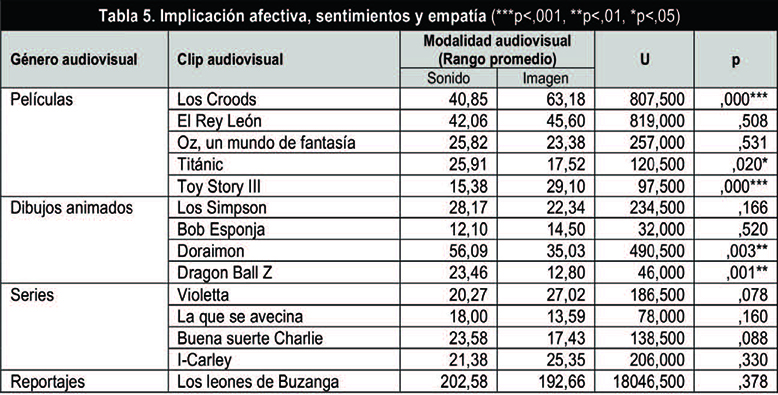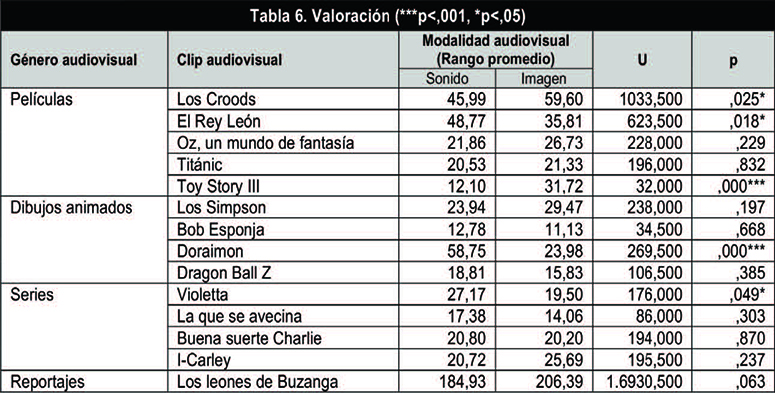Pulsa aquí para ver la versión en Español (ES)
Abstract
Audiovisual media are part of children´s daily life. They build and/or replace a part of the reality that is sometimes preceded. This paper is interested in one of the elements of the audiovisual binomial, the soundtrack, in order to analyse its meaning and sense from the children’s point of view. The objectives are: to determine if the audiovisual media clips to which children are exposed (sound, image and all) are perceived differently; to establish the possible differences in the assessment they make when comparing the sound and image presentation modalities. Fourteen audiovisual media (movies, series, cartoons and documentaries) were identified by 115 children (10-12 years old) as preferred. Audiovisuals were edited in three modalities (sound, image, and all) and grouped into different series of three clips, which were watched in group sessions by 547 Spanish and Argentinian children (mean age: 11 years old). An Assessment Questionnaire of audiovisual clips was designed and implemented. Results showed differences in the meaning of the soundtrack in three of the five categories of the questionnaire. The significant predominance of the sound in series, documentaries and, especially, movies is highlighted. Contextual space-time elements, affective implications, feelings, and empathy as well as assessment of the experience are all perceived by means of the sound (the music).
1. Introduction
1.1. The audiovisual binomial in the children’s daily life
Eco (1972: 26) notes that culture as a whole can be better understood if it is approached from the semiotic plane. Audiovisual media today form part of an infant’s daily life. Within this living environment, music and Media form an inseparable binomial. Film and television are produced industrially, and are directed to a large unknown audience, separated by age groups, but are always received individually and privately (Benjamin, 1983: 7-8). It is in this manner, individual and private, that the music develops significance and meanings with which the children interact and understand the world that surrounds them. Therefore, music from audiovisual media is similar to the functions of popular music as according to Frith (2001): “the creation of identity, the management of feelings and the organization of time”. At present, children live in a world that is shown in screens, sometimes preceding or substituting what is real. From the audiovisual binomial, we are interested in the soundtrack, comprised of texts or speeches (Cohen, Manion, & Morrison, 2013), which we will approach through their modes of listening (Porta, 2014).
1.2. Audiovisual media tell stories and construct worlds
When reviewing the literature, different works were found that analysed audiovisual media as constructors of the infant’s reality (Del-Río, Álvarez, & Del Río, 2004). Multiple authors have studied their music (Aguaded, 2010; Denora, 2000; Morley, 2003; Porta, 2007, 2011; Sloboda, 2005). In film, diverse works were also identified (Adorno, 2009; Campbell, 2010; Chion, 2013; Hauser, Tovar, & Varas-Reyes, 1969). Among the functions of music, the transmission of emotions that intervene in the tension of the events and characters is noted (Tan, Cohen, Lipscomb, & Kendall, 2013). In Spain, Fraile (2007) proposed a functional analysis of music, identifying features that were expressive and those that were significant/narrative. More specifically, children’s audiovisual media tell stories and create worlds, so that they require specific treatment, with different approaches studied from different points of view. Also, Xalabarder (2006) thinks of music in a film as a narration tool. Similarly, Igartúa and Muñiz (2008) have studied the emotions provoked by psychoanalytical models, opting for open-ended questionnaires and interviews after their viewing. Lastly, Salomon, Perkins and Globerson (1992) have studied their cognitive effects and of meaning, creating approaches that are indispensable for cognitive development, psycholinguistics and communication systems. Their studies on the singularity of mental processes, produced by the media, the development of specific skills and its system of symbols, are highlighted.
1.3. Modes of listening
The origin of the word modes in film studies come from the dissatisfaction when isolating its elements and the need to observe it as parts of a whole (Kress & Van-Leeuwen, 2001). This approach coincides with the integrative approaches from inter-cultural studies and critical pedagogy (Hargreaves & North, 1999; McLaren & Kincheloe, 2008). As for listening, Swanwick (1991), coming from music education, has established three related modes: idiomatic, symbolic and systematic, highlighting in this research the systematic one, which explains how the musical experience is transformed into complex conceptual and analysis schemes. The third element that should be noted comes from ethnomusicology. Pelinski (2007) points to three modes of listening to the sound environment: natural listening, linked to sensation and the pre-conscious; reduced listening, a focused listening that links alert consciousness as the previous state of the analytical and conceptual functions through auditory perception; and lastly, privileged listening, a type of listening that is able to integrate emotional processes with analytical ones and the pre-conceptual perception, all of this joined to the consciousness of the musical properties of the object experienced.
1.4. To understand the meaning and sense of the music from audiovisual media
The habitat comprises the space where meaning and sense are initially and preferentially constructed, immersion being the most important aspect, which is constructed with what is found on the road to understanding. The organizer of this complex process is initially perception, an element that generates thought through selective attention ruled by the laws of perception: structural unity, perceptual constancy and figure-ground perception. The structure of musical comprehension and the meaning of the world of music is constructed on its base. The music from film and television that children listen to has a discursive and multimodal character. It is not a unidirectional space, it is a space of interaction created by commercial means in which a story is told with music and moving images (Ma, 2014). Audiovisual media transport the children to a space of fiction, with characters that live a story in which they participate and understand due to the sum of its languages, producing meaning. This article aims to explore this space of interaction from the music angle. In the review of the subject, the search engines that have given form to the design of the research have mainly been territory, meaning, film and television as a space for communication (Porta, 2007); secondly, meaning and sense, as studied through Semiotics (Peirce, Bonfantini, & Grassi, 1980) and meaning (Greimas, Bardón, & Sierra, 1973; Pitt & Hargreaves, 2016); and third, its understanding, approached through Psychology and Education (Tan & al., 2013). Lastly, for its understanding, the re-structuration theories from Cognitive Psychology are taken into account. These theories, constructive in character, use molar units due to their important character, and are considered by authors such as Piaget (1975), Vygotsky (1996) and the Gestalt school (Koffka, 2013; Perls, 1969). This contribution is extremely valuable, as it moves the load towards context, its habitat and elements of meaning that, as experienced, never appear to be separated. With this triangulation of elements, a research design is constructed, based on modes, the individual character and the use of molar units in the analysis. Starting with these principles, the initial basis of this research was created: a) to use separate versions (only sound, only image and all); b) Complete scenes and c) Search of coincidences and singularities with closed and open questions. In this article, the quantitative analysis of numerical data is presented with two objectives: 1) To determine if children perceive, in different ways, the categories that comprise the audiovisual media clips to which they are exposed. 2) To establish, in each one of the audiovisual media clips employed, the possible differences in their assessment when comparing the sound and image modalities of presentation. The starting hypothesis is that differences will be found in the children’s perception as a function of the audiovisual modality presented.
The aim of this article is to understand the meaning and sense of the children’s favourite audiovisual soundtrack, after their presentation, in line with previous studies (Ma, 2014; Tan & al., 2013).
2. Materials and methods
2.1. Participants
An incidental type, non-probabilistic sampling was employed, in which a sample was selected due to the accessibility to the educational centres. 547 students participated, from which 375 were Spanish (68.6%) and 172 Argentinian (31.4%). From Spain, seven cities from three provinces participated: Castellón (31.8% of the total sample), Valencia (24.1%) and Granada (12.6%). In Argentina, the children lived in three cities from two communities: Chaco (24.1%) and Corrientes (7.3%). According to gender, 242 were boys (44.2%) and 305 girls (55.8%), aged between 9 and 15 years old, with an average age of 11.42 years old (SD=.84).
They belonged to 22 educational centres. 72.8% (n=398) studied in public centres, 11.9% in private/public centres, and 15.4% in private centres (n=84). As for the educational stage, 367 were enrolled in the third cycle of Primary Education (67.1%), with a greater number in sixth grade (n=321, 87.5%) and 180 were enrolled in the first cycle of Secondary Education (32.9%), main from the first year (n=160, 88.9%).
2.2. Instruments
Different audiovisual media clips and an associated questionnaire that the students had to complete were used as the tools for gathering information. These are described below.
2.2.1. Audiovisual media clips
Initially, an exploratory study was conducted in order to establish a relationship between the films, cartoons, series and documentaries that the children aged between 10 and 12 years of age preferred. For this, 115 children participated, and they were asked what their favourite was from each of the four types of audiovisual forms. Also, their character (local, national or international) and their characteristics were determined in order to extract clips.
Once the audiovisual media and their characteristics were obtained, the most frequent ones were selected. Thus, 14 audiovisual clips were selected, of which five belonged to films (“The Croods”, “The Lion King”, “Oz, the great and powerful”, “Titanic”, “Toy Story III”), four were cartoons (“The Simpsons”, “Sponge Bob”, “Doraemon”, “Dragon Ball Z”), four were television series (“Violetta”, “La que se avecina”, “Good-Luck Charlie”, “iCarly”), and one was part of a documentary (“The lions of Busanga”).
Each of the clips was edited into three versions: sound (S), image (I) or all (A). Then, the children from each class were subjected to a sequence comprised of three clips, each clip with a different version (S, I or A). The sequence could be, as a function of the audiovisual form, cartoons-documentary-film (sequences 01 to 12) or film-series-documentary (sequences 13-24). Table 1 shows each sequence. The first element of each clip refers to the audiovisual form, meaning, F=film, C=cartoons, S=series, D=documentary. The second element, in the case of three elements, was the number relating to the film, cartoons or series in question. Lastly, the third element (or second when there were only two) was related to the audiovisual version, meaning, S=sound, I=image, A=all.
2.2.2. Questionnaire for the assessment of audiovisual clips
A questionnaire for the assessment of the audiovisual clips was designed. For the validation of the content, 14 experts from different areas participated (music, image and methods). The criteria by Barbero (2006) were used for the interjudge validation. This means that the experts were asked to show their degree of agreement with respect to the suitability of the items in each category, and later, the degree of interjudge agreement was established. For this, the mean, median, 50th percentile and interjudge dispersion (75th and 25th percentile) were used.
The final questionnaire, adapted to each audiovisual modality (S, I, A), was composed of 53 items that were grouped into five categories:
• Contextual aspects of space and time (items 1 to 7). For example, “it was daytime during the story”.
• Characters and story (items 8 to 21), for example, “a character is identified”.
• Musical aspects (items 22 to 31), for example “musical instruments could be heard”.
• Affective implication, feelings and empathy (items 32 to 37), for example, “I would like to be in that story”.
• Assessment (items 38 to 53), for example, “what was presented captured my attention”.
In the first four categories, the items had dichotomous answers (Yes or No), including some open-ended questions. The last category was structured around a four-answer, Likert-type scale (Nothing, Little, A lot, Much).
A pilot test was conducted with 23 children aged 10 years old, with the aim of determining if they could understand the questionnaire by themselves. Also, the reliability of the questionnaire was calculated once the questionnaire was completed by all the participants of the study through the internal consistency Alpha of Cronbach index, obtaining a value of .972. Likewise, for the each of the audiovisual versions, we found: Sound, ?=.885; Image, ?=.858; All, ?=.934.
2.3. Procedure2.3.1. Gathering of information
Authorization was solicited from the participating educational centres. Once obtained, an hour of class was selected with the aim of briefly presenting the students the object of the study as well as explaining to them what it entailed. Each class group had been assigned with a sequence composed of three clips. When each clip ended, a questionnaire was completed as a function of the audiovisual modality within which they had been presented (S, I, A).
2.3.2. Statistical analysis of data
While the items from the first four answer categories of the questionnaire were qualitative, nominal and dichotomous, the items of the fifth category were ordinal (due to the use of the Likert-type scale). A summary of the items of each of the categories was conducted in order to transform the dependent variables (the five categories of the questionnaire) into discrete quantitative variables.
Afterwards, the distribution of the data was analysed to determine the type of statistical tests to be used (parametric or non-parametric). Therefore, the Kolmogorov-Smirnov test was applied, which was found to be significant for the five categories of the questionnaire p<.001, so the data did not have a normal distribution. Also, their homoscedasticity or homogeneity of variances through Levene’s test for the comparison groups (S, I, A) was calculated. The null hypothesis was not accepted in the case of the contextual aspects space and time, F(2, 1638)=6.003, p=.003 and musical aspects, F(2, 1638)=14.193, p=.000.
Due to what has been described above, a non-parametric test was conducted (Hollander, Wolfe, & Chicken, 2014). Hence, for the analysis of the three audiovisual modalities presented, a Kruskal-Wallis H-test for K independent variables was used. Also, the Mann-Whitney U independent test for 2 samples was used for each of the two versions, i.e. Sound and Image, Sound and All and in third place, Image vs All.
In order to answer the second objective of the study, non-parametric tests were used as well. The Mann-Whitney U test was used for comparing each audiovisual clip of the modalities Sound as opposed to Image.
3. Analysis and results
The descriptive frequencies are specified in this section for each audiovisual media employed as well as the sequence of the clips as a function of genre and audiovisual modality. In respect of this, the frequency and percent of the answer for each one of these clips were the following: “The Croods”: 160 (9.8%); “The Lion King”: 134 (8.2%); “Oz, the great and powerful”: 72 (4.4%); “Titanic”: 54 (3.3%); “Toy Story III”: 128 (7.8%); “The Simpsons”: 71 (4.3%); “Sponge Bob”: 49 (3.0%); “Doraemon”: 128 (7.8%); “Dragon Ball Z”: 52 (3.2%); “Violetta”: 72 (4.4%); “La que se avecina”: 53 (3.2%); “Good Luck Charlie”: 60 (3.7%); “iCarlie”: 61 (3.7%); “The lions of Busanga”: 547 (33.3%).
As for the audiovisual form of the clips, 547 were films (33.3%, 301 were cartoons (1.3%), 246 were series (15.0%) and 547 documentaries (33.3%). Also, as each one of the clips could be presented in one of the three audiovisual modalities planned, the frequency of each of them (S, I, A) was the same in every case, n=547 (33.3%).
The frequencies and percentages of each audiovisual sequence, according to audiovisual genre and modality, were 60 (3.7%) for SEQ01, SEQ04, SEQ07, SEQ08, SEQ12, SEQ13, SEQ14 and SEQ15. For the sequences SEQ02 and SEQ11 it was 75 (4.6%). In SEQ03=249 (15.2%); SEQ05=57 (3.5%); SEQ06=39 (2.4%); SEQ09=96 (5.9%); SEQ10=12 (.7%); SEQ16=93 (5.7%); SEQ17=42 (2.6%); SEQ18=48 (2.9%); SEQ19=66 (4.0%); SEQ20=78 (4.8%); SEQ21=72 (4.4%); SEQ22=51 (3.1%); SEQ23=69 (4.2%); SEQ24=39 (2.4%).
With the aim of determining if the children perceived the categories that composed the audiovisual clips to which they were exposed, differently as a function of the modality of presentation (S, I, A), a Kruskal-Wallis H test was used for the five categories of the assessment questionnaire of the audiovisual media clips. The results brought to light the differences, according to the audiovisual modality, in the categories of the contextual aspects space and time, ?2=49.818, p=.000; musical aspects, ?2=877.882, p=.000; and assessment, ?2=10.060, p=.007.
Along with the statistics analysis, the Mann-Whitney U test was used to compare, in the three categories that differed as a function of the modality presented, each pair of versions. Then, in the category Contextual aspects of space and time, the lowest scores reached were for the modality Image, so that it differed significantly from the modality sound, U=115362.000, p=.000, as well as the all modality, U=24.811, p=.000.
In the category musical aspects, all the modalities differed among them, meaning, sound as compared to image, U=23378.500, p=.000; sound as compared to all U=115543.000, p=.000; and image as compared to all, U=683.351, p=.000. In this way, from high to low score, the following modalities were placed: All, followed by Sound, and in last place, Image.
As for the category Assessment, the modality with the highest punctuations, was All with differences found between this modality and Sound, U= 133426.500, p=.002; as well as Image, U=4.107, p=.043.
On the other hand, to establish, within each of the audiovisual clips employed, the possible differences when comparing the modalities of presentation S vs I, Table 2 shows the results for the category Contextual aspects of space and time.
Differences were found in eight of the fourteen clips, which belonged to the four audiovisual forms utilised. In seven of them the contextual aspects of space and time for the modality S was higher than for I. These were specifically “The Lion King”, “Titanic”, “Doraemon”, “Dragon Ball Z”, “Violetta”, “La que se avecina” and “The lions of Busanga”. The modality I was only higher than S in the series “Good luck Charlie”.
As for the category of characters and story, Table 3 shows the results for the two modalities of presentation analysed.
In this category, the differences between S and I were found in five clips, found in the audiovisual genres of films, cartoons and documentaries. More specifically, the scoring of the characters and history was higher in the modality I as compared to S (“Toy Story III”, “Dragon Ball Z” and “The lions of Busanga”).
As for the musical aspects (Table 4), the differences were significant in all the audiovisual media clips when analyzing the modality S as compared to I.
It is in this category, due to the intrinsic character of what it measures (musical aspects), that the supremacy of the modality S as compared to I is found in all the audiovisual media clips used.
The category Affective implication, feelings and empathy is shown in Table 5 (see next page)..
The differences between the modalities of presentation were found in the films and cartoons audiovisual forms, without differences being found in series and documentaries. Within the films “The Croods” and “Titanic”, the category affective implication, feelings and empathy were higher in the modality S as compared to I, while in “Toy Story III”, it was the opposite. In the cartoons, in “Doraemon” as well as in “Dragon Ball Z”, modality S obtained higher scores than I. Lastly, Table 6 shows the answers from the category Assessment from each audiovisual clip.
Except for the audiovisual genre documentaries, differences were found in the rest, according to the audiovisual modality. Therefore in the films “The Croods” and “Toy Story III”, I was better assessed as compared to S, while in “The Lion King” modality S received a higher score. Within the cartoons, “Doraemon” was better assessed in modality S than I. Lastly, in the series “Violetta”, modality S also scored higher.
4. Discussion and conclusions
In this work, the effects of the music from audiovisual media in children were explored, creating a research design that used the modes of listening as the constructive elements (Porta, 2014) and the principles of post-structuralism on the meaning (Vigotsky, 1996), with the aim of understanding from its interpretation. The experiencing of different audiovisual media in three different versions (only sound, only image and all) has resulted in a detailed analysis that has confirmed the starting hypothesis. In general terms, it can be confirmed that the soundtrack offers meaning and sense to the narrative as well as the multimedia experience. A transversal tour shows the importance of the sound in their favourite audiovisual media. As an answer to the objectives posed, the audiovisual modality of presentation of the clips was perceived differently by the participants in three of the five categories of analysis. More specifically, it affected the perception of the Contextual aspects of space and time, so that the image alone was not enough, with these aspects being understood better when only the sound or the complete version, were presented. Likewise, the Musical aspects were better perceived by the participants, in first place, when the complete audiovisual was presented; in second place when it was only the sound; and in third place, with the modality Image. Lastly, in the category Assessment, the participants had a better opinion when they counted with all the information, meaning, when the modality of presentation was All.
It is remarkable that there were no differences, as a function of the modality of presentation, in the categories Characters and story and Affective implication, feelings and empathy.
On the other hand, when thoroughly analysing each audiovisual clip, the responses of the subjects according to the modality sound and image, in the category “contextual aspects of space and time”, resulted in statistically-significant differences in the four audiovisual forms used, meaning, in the films, cartoons, series and documentaries. As for the films, in “The Lion King” as well as in “Titanic”, the scores were higher in the audiovisual modality Sound as compared to Image. Within the cartoons, “Doraemon” and “Dragon Ball Z” showed the same tendency that the previous clips. Also, in three of the four Series shown, there were differences as a function of the audiovisual modality. More specifically, in “Violetta” and “La que se avecina”, the assessment was higher with the modality sound; while in the series “Good Luck Charlie”, the higher scores were obtained with the modality Image. Lastly, the greater score in the modality of presentation Sound within the audiovisual form documentaries, was notable.
On its part, in the category characters and story, differences were obtained according to the audiovisual modality employed in the different audiovisual genres, except for the genre Series. More specifically, in the genre of films, the assessment by the children was higher in the modality of Sound for “Oz, the great and powerful” while in “Toy Story III”, the best assessment was found in the modality of Image. Similar results were found in the genre of cartoons, where in “Sponge Bob” the modality of Sound was prioritized, while in “Dragon Ball Z”, Image was prioritized. Also, in the genre Documentaries, the Image predominated over Sound.
In the category of musical aspects, as expected, there were differences in favour of sound in all the audiovisual media clips used in audiovisual genre.
Continuing with the category of affective implication, feelings and empathy, there were differences in the forms of films and cartoons. In the films “The Croods” and “Toy Story III”, the scores were higher for the modality Image, while in “Titanic” and “The Lion King”, these were found in the Sound modality. Conversely, in the cartoons “Doraemon” and “Dragon Ball Z”, the assessment was higher in the modality of Sound.
In the last category, Assessment, there were differences between Sound and Image in the genres of films, cartoons and series. Within films, in “The Croods” and “Toy Story III”, there were higher assessments in the modality Image. However, in “The Lion King”, the scores were higher for Sound. In the cartoons “Doraemon” and in the series “Violetta”, the audiovisual modality of Sound also predominated.
This research has allowed for a better understanding of the meaning and sense of the music from audiovisual media with the study of their component in molar units of meaning through complete scenes from their favourite audiovisual media. It was verified that in many occasions, music made sense by itself, many times being more significant than the image. In this study, the participants indicated that music provided them with space-time guiding elements, requiring more attention and maintaining interest. These elements are decisive in the world of fiction that the audiovisual media create, a world that would be different if the music was different. Likewise, the loss, first of interest, and later of meaning, was observed when music disappeared. The importance of sound shows its superiority in half of the audiovisual media heard, and in three of the five films (“The Lion King”, “Titanic” and “Oz, the great and powerful”), two series (“Violetta” and “La que se avecina”) and three cartoons (“Doraemon”, “Dragon Ball Z” and “Sponge Bob”). In the case of the films, it should be noted that the soundtracks that were better assessed by the participants, due to their meaning and sense in the audiovisual narrative, were also given prizes by the industry of film and music. This is the case for “The Lion King” (1994, a Grammy and two Oscars for best soundtrack and song) and “Titanic” (1997, two Oscars for best soundtrack and song, a Grammy for best song). The results from these films surpassed in Image in the contextual categories of space and time, affective implication, feelings and empathy, and Assessment of the audiovisual experience.
Among the limitations of the study, it was necessary to show that the distribution of the participants was not the same as a function of the country of origin, and the audiovisual sequences were not shown in the same proportion.
The research line began contributed to the study of the daily life of children, helping to understand the context and its repercussions in education (Pitt & Hargreaves, 2016; Tan & al., 2013). This work has tried to show the road that point to education, in general as well as musical, demanding attention towards a high-impact musical environment with which its music contributes to the development of heroes, scenarios and values with a clear growing trend in a world that is increasingly viewed through the screens.
Funding Agency
Project “La televisión como hábitat sonoro. Estudio de los efectos de la banda sonora y sus narrativas audiovisuales en la infancia” from the R+D call from the Spanish Ministry of Economy and Competitiveness (MINECO) (EDU2012-36404).
References
Adorno, T.W. (2009). Disonancias/introducción a la sociología de la música (Vol. 14). Madrid: Akal. (https://goo.gl/W0TMQt) (2016-03-15).
Aguaded, I. (2010). La Unión Europea dictamina una nueva recomendación sobre alfabetización mediática en el entorno digital en Europa. [The European Union Passes a Recommendation on Media Literacy in the European Digital Environment]. Comunicar, 34(XVII), 7-8. https://doi.org/10.3916/C34-2010-01-01
Barbero, M.I. (Coord.) (2006). Psicometría. Madrid: UNED.
Benjamin, W. (1983). La obra de arte en la época de su reproductibilidad técnica. In W. Benjamin (Ed.), Discursos interrumpidos (pp. 15-57). Madrid: Taurus.
Campbell, P.S. (2010). Songs in Their Heads: Music and its Meaning in Children’s Lives. Oxford: Oxford University Press. (https://goo.gl/IBzQhl) (2016-08-14).
Chion, M. (2013). L'audio-vision: Son et image au cinéma. Paris: Armand Colin. (https://goo.gl/bko3Ou) (2016-01-22).
Cohen, L., Manion, L., & Morrison, K (2013). Research Methods in Education. Hoboken: Taylor and Francis. (https://goo.gl/y4uQdu) (2016-02-18).
Del-Río, P., Álvarez, A., & Del-Río, M. (2004). Pigmalión. Informe sobre el impacto de la televisión en la infancia. Madrid: Fundación Infancia y Aprendizaje. (https://goo.gl/fEv3OZ) (2016-04-01).
DeNora, T. (2000). Music in Everyday Life. Cambridge: Cambridge University Press. (https://goo.gl/gAq4Vt) (2016-09-13).
Eco, U. (1972). La estructura ausente. Barcelona: Lumen.
Fraile, T. (2007). El elemento musical en el cine. Un modelo de análisis. In J.J. Marzal, & F.J. Gómez (Eds.), Metodologías de análisis del film (pp. 527-538). Madrid: Edipo. (https://goo.gl/f5eBim) (2016-03-17).
Frith, S. (2001). Hacia una estética de la música popular. Lecturas en Etnomusicología. Madrid: Trotta.
Greimas, A., Bardón, S., & Sierra, F. (1973). En torno al sentido: Ensayos semióticos. Madrid: Fragua.
Hargreaves, D., & North, A. (1999). The Functions of Music in Everyday Life: Redefining the Social in Music Psychology. Psychology of Music, 27(1), 71-83. https://doi.org/10.1177/0305735699271007
Hauser, A., Tovar, A., & Varas-Reyes, F. (1969). Historia social de la literatura y el arte (Vol. 3). Madrid: Guadarrama.
Hollander, M., Wolfe, D.A., & Chicken, E. (2014). Nonparametric Statistical Methods. Hoboken: John Willey & Sons. (https://goo.gl/sp5KnA) (2016-01-30).
Igartua, J., & Muñiz, C. (2008). Identificación con los personajes y disfrute ante largometrajes de ficción. Una investigación empírica. Comunicación y Sociedad, 21(1), 25-52. (https://goo.gl/El3BMJ) (2016-07-15).
Koffka, K. (2013). Principles of Gestalt Psychology. London: Routledge. (https://goo.gl/lQ7d5W) (2016-05-29)
Kress, G., & Van-Leeuwen, T. (2001). Multimodal Discourse. The Modes and Media of Contemporary Communication. London: Arnold. (https://goo.gl/ytSv0Z) (2016-01-16).
Ma, J. (2014). The Synergy of Peirce and Vygotsky as an Analytical Approach to the Multimodality of Semiotic Mediation. Mind, Culture, and Activity, 21(4), 374-389. https://doi.org/10.1080/10749039.2014.913294
McLaren, P., & Kincheloe, J. (2008). Pedagogía crítica: De qué hablamos, dónde estamos (Vol. 23). Barcelona: Graó. (https://goo.gl/aaVyYP) (2016-04-15).
Morley, D. (2003). Television, Audiences and Cultural Studies. London: Routledge. (https://goo.gl/QOcip4) (2016-01-08).
Peirce, C., Bonfantini, M., & Grassi, L. (1980). Semiotica: I fondamenti della semiotica cognitiva. Torino: Einaudi. (https://goo.gl/ong88r) (2015-12-06).
Pelinski, R. (2007). El oído alerta: Modos de escuchar el entorno sonoro. In Instituto Cervantes (Ed.), I Encuentro Iberoamericano sobre Paisajes Sonoros. Madrid: Centro Virtual Cervantes. (https://goo.gl/LB1oZS) (2016-05-23).
Perls, F. (1969). Gestalt Therapy Verbatim. Lafayette: Real People Press.
Piaget, J. (1975). La representación del mundo en el niño. Madrid: Morata.
Pitt, J., & Hargreaves, D.J. (2016). Attitudes towards and Perceptions of the Rationale for Parent-child Group Music Making with Young Children. Music Education Research, 1-17. Advance online publication. https://doi.org/10.1080/14613808.2016.1145644
Porta, A. (2007). Músicas públicas, escuchas privadas: Hacia una lectura de la música popular contemporánea (Vol. 20). Valencia: Universitat de València. (https://goo.gl/ua9hgn) (2016-03-01)
Porta, A. (2011). La oferta musical de la programación infantil de TVE como universo audible. [The Musical Offers of Children’s Programming on Televisión Española as its Hearing Universe]. Comunicar, 37(XIX), 177-185. https://doi.org/10.3916/C37-2011-03-10
Porta, A. (2014). Los modos de escucha televisiva. In J. Gustems (Coord.), Música y audición en los géneros audiovisuales (pp. 53-67). Barcelona: Universitat de Barcelona. (https://goo.gl/OFo6mQ) (2016-01-26)
Salomon, G., Perkins, D., & Globerson, T. (1992). Coparticipando en el conocimiento: La ampliación de la inteligencia humana con las tecnologías inteligentes. Comunicación, Lenguaje y Educación, 4(13), 6-22. https://doi.org/10.1080/02147033.1992.10820997
Sloboda, J. (2005). Exploring the Musical Mind: Cognition, Emotion, Ability, Function. Oxford: Oxford University Press. https://doi.org/10.1093/acprof:oso/9780198530121.001.0001
Swanwick, K. (1991). Música, pensamiento y educación (Vol. 24). Madrid: Morata. (https://goo.gl/pKrmmb) (2015-07-18).
Tan, S.L., Cohen, A.J., Lipscomb, S.D., & Kendall, R.A. (2013). The Psychology of Music in Multimedia. Oxford: Oxford University Press. https://doi.org/10.1093/acprof:oso/9780199608157.001.0001
Vigotsky, L. (1996). Pensamiento y lenguaje. Teoría del desarrollo cultural de las funciones psíquicas. Buenos Aires: La Pléyade.
Xalabarder, C. (2006). Música de cine. Una ilusión óptica. Buenos Aires: LibrosEnRed. (https://goo.gl/PHTtce) (2016-02-07).
Click to see the English version (EN)
Resumen
Los audiovisuales forman parte de la vida cotidiana de la infancia, construyendo con ellos una parte de la realidad que muchas veces se anticipa y otras sustituye. Este artículo se interesa por una de las partes del binomio audiovisual, la banda sonora, con la finalidad de conocer su significado y sentido desde la propia interpretación infantil. Sus objetivos son determinar si los niños perciben de modo diferente los clips audiovisuales a los que son expuestos (sonido, imagen y todo); establecer las posibles diferencias en la valoración que realizan comparando las modalidades de presentación sonido e imagen. Se identificaron 14 audiovisuales preferidos (películas, series, dibujos animados y reportajes) por parte de 115 niños de 10 a 12 años. Fueron editados en tres modalidades (solo sonido, solo imagen y todo) y agrupados en series de tres clips, que fueron visionados en sesiones grupales por 547 niños, españoles y argentinos, con una edad media de 11 años. Se diseñó y utilizó un cuestionario de valoración de clips audiovisuales. Los resultados mostraron diferencias sobre el significado de la banda sonora en tres de las cinco categorías del cuestionario, destacando el predominio significativo del sonido en series, reportajes y, de manera destacada, en películas. Se perciben por el sonido (la música) elementos contextuales espacio-tiempo, la implicación afectiva, sentimientos y empatía así como la valoración de la experiencia.
1. Introducción
1.1. El binomio audiovisual en la vida diaria de los niños
Eco (1972: 26) apunta que la cultura en su conjunto puede comprenderse mejor si se aborda desde un plano semiótico. Los audiovisuales hoy forman parte de la vida cotidiana de la infancia y, en este entorno vivo, música y «media» forman un binomio inseparable. El cine y la televisión tienen una producción industrial, dirigida a un público desconocido, separado por franjas de edad y muy amplio, pero siempre se reciben de forma individual y privada (Benjamin, 1983: 7-8). Es así, de forma individual y privada, cómo sus músicas desarrollan significados y sentidos con los que los niños interaccionan y comprenden el mundo que les rodea. De este modo, la música audiovisual se asimila a las funciones de la música popular de Frith (2001): «la creación de la identidad, el manejo de sentimientos y la organización en el tiempo». Actualmente, los niños viven en un mundo representado en pantallas que muchas veces se anticipa o sustituye a lo real. Del binomio audiovisual, nos interesa la banda sonora, constituida por textos o discursos (Cohen, Manion, & Morrison, 2013), a los que nos acercaremos a través de sus modos de escucha (Porta, 2014).
1.2. Los audiovisuales cuentan historias y construyen mundos
Al revisar la literatura, se hallan diferentes trabajos que analizan los audiovisuales como constructores de la realidad en la infancia (Del-Río, Álvarez, & Del Río, 2004). Han estudiado su música múltiples autores (Aguaded, 2010; Denora, 2000; Morley, 2003; Porta, 2007, 2011; Sloboda, 2005). En el cine, igualmente, se identifican diversos trabajos (Adorno, 2009; Campbell, 2010; Chion, 2013; Hauser, Tovar, & Varas-Reyes, 1969). Entre sus funciones, destaca la de transmitir emociones, interviniendo en la tensión eventos y personajes (Tan, Cohen, Lipscomb, & Kendall, 2013). En España, Fraile (2007) propone un análisis funcional de la música, distinguiendo las expresivas y las significativas/narrativas. Especialmente, los audiovisuales en la infancia cuentan historias y crean mundos, por ello requieren un tratamiento específico del que se derivan diferentes aproximaciones estudiadas desde distintos puntos de vista. Así, Xalabarder (2006) considera la música en el cine como una herramienta narrativa. Por su parte, Igartúa y Muñiz (2008) estudian las emociones que provocan con referentes psicoanalíticos en los que optan por encuestas abiertas y entrevistas después del visionado. Y, finalmente, Salomon, Perkins y Globerson (1992) estudian sus efectos cognitivos y de significación, creando aproximaciones imprescindibles en el presente estudio, analizando los procesos de pensamiento mediante la interpretación semiótica del desarrollo cognitivo, la psicolingüística y los sistemas de comunicación. Destacan sus estudios sobre la singularidad de los procesos mentales, producidos por los media, el desarrollo de habilidades específicas y sus sistemas de símbolos.
1.3. Los modos de escucha
El origen de la palabra «modus» surge en los estudios sobre la comprensión fílmica, de la insatisfacción al aislar sus elementos y la necesidad de observarlos como partes de un todo (Kress & Van-Leeuwen, 2001). Dicho planteamiento es coincidente con las propuestas integradoras de los estudios interculturales y la pedagogía crítica (Hargreaves & North, 1999; McLaren & Kincheloe, 2008). Respecto a la escucha, desde la educación musical, Swanwick (1991) establece tres modos relacionados: idiomático, simbólico y sistemático, destacando en esta investigación el sistemático, en el que se explica cómo la experiencia musical se transforma en esquemas conceptuales y análisis complejos. El tercer elemento a destacar proviene de la etnomusicología. Pelinski (2007) señala tres modos de escucha del entorno sonoro: la escucha natural, vinculada a la sensación y el pre-consciente; la escucha reducida, una escucha focalizada vinculando a través de la percepción auditiva la conciencia alerta como estadio previo a las funciones analíticas y conceptuales; y, finalmente, la escucha privilegiada, una escucha capaz de integrar los procesos emocionales con los analíticos y la percepción preconceptual, todo ello unido a la conciencia de las propiedades musicales del objeto vivenciado.
1.4. Conocer el significado y sentido de la música audiovisual
El hábitat constituye el espacio donde se construye inicial y preferentemente el significado y sentido, siendo su mayor responsable la inmersión, y construyéndose con aquello que se encuentra en el camino hacia la comprensión. El organizador de este complejo proceso es inicialmente la percepción, elemento generador del pensamiento, mediante una atención selectiva regida por las leyes perceptivas: la unidad estructural, la constancia perceptiva y la percepción figura-fondo. Sobre su base se construye el edificio de la comprensión musical y el sentido del mundo sonoro. La música del cine y la televisión que escuchan los niños tiene carácter discursivo y multimodal. No es un espacio unidireccional, es un espacio de interacción creado por resortes comerciales en el que se cuenta una historia con música e imágenes en movimiento (Ma, 2014). Los audiovisuales transportan a los niños a un espacio de ficción, con unos personajes que viven una historia en la que participan y comprenden por la suma de sus lenguajes, produciendo sentido. Este artículo tiene por finalidad explorar ese espacio de interacción desde el lado de la música. En la revisión del tema, los motores de búsqueda que han dado forma al diseño de la investigación han sido, en primer lugar, el territorio, esto es, el cine y la televisión como espacio comunicativo (Porta, 2007); el segundo, el significado y sentido, estudiados por la Semiótica (Peirce, Bonfantini, & Grassi, 1980) y el sentido (Greimas, Bardón, & Sierra, 1973; Pitt & Hargreaves, 2016); y, el tercero, su comprensión, abordado por la Psicología y la Educación (Tan & al., 2013). Para este último, su comprensión, se consideran las teorías de la reestructuración de la Psicología Cognitiva, de carácter constructivista, que utilizan unidades molares por su carácter significativo, con autores como Piaget (1975), Vygotsky (1996) y la escuela de la Gestalt (Koffka, 2013; Perls, 1969). Esta aportación es sumamente valiosa porque desliza el peso hacia el contexto, su hábitat y elementos de significación que, como ocurre en la experiencia, nunca aparecen separados. Con esta triangulación de elementos se ha construido el diseño de investigación basado en los modos, carácter individual y uso de unidades molares en el análisis. A partir de estos principios, se han creado las bases de partida: a) Utilizar versiones separadas (solo sonido, solo imagen y todo); b) Escenas completas y c) Búsqueda de coincidencias y singularidades con preguntas cerradas y abiertas. En este artículo se muestra el análisis cuantitativo de datos numéricos con dos objetivos: 1) Determinar si los niños perciben de modo diferente las categorías que integran los clips audiovisuales a los que son expuestos (sonido, imagen y todo); 2) Establecer en cada uno de los clips audiovisuales empleados las posibles diferencias en la valoración que realizan comparando las modalidades de presentación sonido e imagen. La hipótesis de partida es que se hallarán diferencias en las apreciaciones de los niños en función de la modalidad audiovisual presentada.
La finalidad de este artículo es conocer cuál es el significado y sentido de la banda sonora de los audiovisuales favoritos de los niños desde su propia interpretación, siguiendo la línea de otros estudios anteriores (Ma, 2014; Tan & al., 2013).
2. Material y método
2.1. Participantes
Se empleó un muestreo no probabilístico de tipo incidental en el que se seleccionó la muestra por la accesibilidad a los centros educativos. Participaron 547 estudiantes, de los cuales 375 eran españoles (68,6%) y 172 argentinos (31,4%). En España se contó con la participación de siete ciudades pertenecientes a tres provincias: Castellón (31,8% de la muestra total), Valencia (24,1%) y Granada (12,6%). En Argentina los niños vivían en tres localidades de dos comunidades: Chaco (24,1%) y Corrientes (7,3%). Por género, 242 eran niños (44,2%) y 305 niñas (55,8%), con edades comprendidas entre los 9 y 15 años, siendo la edad media de 11,42 años (DT=,84).
Pertenecían a 22 centros educativos. El 72,8% (n=398) estudiaba en centros públicos, el 11,9% en centros concertados (n=65) y el 15,4% en centros privados (n=84). Respecto a la etapa educativa que se hallaban cursando, 367 estudiaban el tercer ciclo de Educación Primaria (67,1%), destacando los de sexto curso (n=321, 87,5%), y 180 cursaban el primer ciclo de Educación Secundaria (32,9%), principalmente primer curso (n=160, 88,9%).
2.2. Instrumentos
Como instrumentos de recogida de información se emplearon diferentes clips audiovisuales y un cuestionario asociado que debían contestar los estudiantes. A continuación se describen los mismos.
2.2.1. Clips audiovisuales
En primer lugar, se realizó un estudio exploratorio con la finalidad de establecer una relación de aquellas películas, dibujos animados, series y reportajes que los niños con edades comprendidas entre 10 y 12 años preferían. Para ello, participaron 115 niños a los que se les preguntó cuál era el que más les gustaba de cada uno de los cuatro tipos de géneros audiovisuales. Y se determinó su carácter (local, nacional o internacional) así como sus características para poder extraer clips de los mismos.
Una vez obtenida la relación de audiovisuales y sus características, se seleccionaron los más frecuentes, esto es, 14 clips audiovisuales, de los cuales cinco pertenecían a películas («Los Croods», «El Rey León», «Oz, un mundo de fantasía», «Titanic», «Toy Story III»), cuatro a dibujos animados («Los Simpson», «Bob Esponja», «Doraimon», «Dragon Ball Z»), cuatro a series («Violetta», «La que se avecina», «Buena suerte Charley», «I-Carley») y uno era parte de un reportaje («Los leones de Buzanga»).
Cada uno de los clips se editó en tres versiones: sonido (S), imagen (I) o todo (T). Así, los niños de cada clase eran expuestos a una secuencia formada por tres clips, cada clip con una versión diferente (S, I o T). La secuencia podía ser, en función del género audiovisual, dibujos-reportaje-película (secuencias 01 a 12) o película-serie-reportaje (secuencias 13 a 24). En la Tabla 1 se muestra cada secuencia. El primer elemento de cada clip se refiere al género audiovisual, esto es, p=película, d=dibujos, s=serie, r=reportaje. El segundo elemento, en el caso de tres elementos, es el número relativo a la película, dibujos o serie en cuestión. Por último, el tercer elemento (o segundo cuando solo haya dos) es el relativo a la versión audiovisual, es decir, s=sonido, i=imagen, t=todo.
2.2.2. Cuestionario de valoración de clips audiovisuales
Se diseñó un cuestionario de valoración de clips audiovisuales. En su validación de contenido participaron 14 expertos de diferentes áreas (música, imagen y métodos). Como criterios para la validación inter-jueces se utilizaron los establecidos por Barbero (2006), esto es, se solicitó a los expertos que mostraran su grado de acuerdo respecto a la idoneidad de los ítems en cada categoría y, posteriormente se estableció el grado de concordancia interjueces. Para ello, se atendió al valor de la media, mediana, percentil 50 y la dispersión interjueces (percentil 75; percentil 25).
El cuestionario final, adaptado a cada modalidad audiovisual (S, I, T), estaba formado por 53 ítems que se agrupaban en cinco categorías:
• Aspectos contextuales de espacio y tiempo (ítems 1 a 7), por ejemplo «En la historia era de día».
• Personajes e historia (ítems 8 a 21), por ejemplo, «Se identifica un protagonista».
• Aspectos musicales (ítems 22 a 31), por ejemplo, «Se escuchaban instrumentos musicales».
• Implicación afectiva, sentimientos y empatía (ítems 32 a 37), por ejemplo, «Me gustaría estar en esta historia».
• Valoración (ítems 38 a 53), por ejemplo, «Lo que se ha presentado ha mantenido mi interés».
En las cuatro primeras categorías los ítems eran de respuesta dicotómica (sí o no), incluyendo algunas preguntas abiertas. La última categoría se estructuró en torno a una escala tipo Likert de cuatro puntos (nada, poco, bastante y mucho).
Se realizó una prueba piloto con 23 niños de 10 años con la finalidad de determinar si el cuestionario era comprensible por los mismos. Además, se calculó la fiabilidad del cuestionario una vez cumplimentado por todos los participantes del estudio, mediante el índice de consistencia interna Alfa de Cronbach, obteniendo un valor de ,872. Igualmente, se halló para cada una de las versiones audiovisuales: sonido, ?=,885; imagen, ?=,858; todo, ?=,934.
2.3. Procedimiento2.3.1. De recogida de información
Se solicitó la autorización a los centros educativos participantes y, una vez obtenida, se procedió a seleccionar una hora de clase con el objetivo de poder presentar a los estudiantes brevemente la finalidad del estudio y explicarles en qué iba a consistir. Cada grupo de clase tenía asignado una secuencia formada por tres clips. Al finalizar cada clip, se cumplimentaba el cuestionario de valoración de clips audiovisuales en función de la modalidad audiovisual en la que se hubiese presentado (S, I, T).
2.3.2. De análisis estadístico de datos
Antes de proceder al análisis estadístico de los datos, dado que los ítems de las cuatro primeras categorías de respuesta del cuestionario eran de tipo cualitativo, nominal y dicotómico y, por otra parte, los ítems de la quinta categoría de tipo ordinal (mediante una escala de respuesta tipo Likert), se procedió a hacer el sumatorio de los ítems de cada una de las categorías para transformar las variables dependientes (las cinco categorías del cuestionario) en variables cuantitativas discretas.
Posteriormente, se analizó la distribución de los datos con la finalidad de determinar qué tipo de pruebas estadísticas emplear (paramétricas o no paramétricas). Se empleó para ello la prueba de Kolmogorov-Smirnov, la cual resultó significativa para las cinco categorías del cuestionario, p<,001, por lo que los datos no se ajustaban a la distribución normal. También se determinó si se cumplía la homocedasticidad u homogeneidad de varianzas, a través del estadístico de Levene, para los grupos de comparación (S, I, T). No se cumplió la hipótesis nula en el caso de las categorías de aspectos contextuales de espacio y tiempo, F(2, 1638)=6,003, p=,003, y aspectos musicales, F(2, 1638)=14,193, p=,000.
Por lo descrito previamente, se optó por llevar a cabo pruebas no paramétricas (Hollander, Wolfe, & Chicken, 2014). De este modo, para el análisis de las tres modalidades audiovisuales presentadas, se empleó la prueba para K muestras independientes H de Kruskal-Wallis. Además, se utilizó la prueba para dos muestras independientes U de Mann-Whitney con el objetivo de comparar, en aquellas categorías que diferían en función de la modalidad presentada, cada par de versiones, esto es, sonido frente a imagen, sonido frente a todo y, en tercer lugar, imagen frente a todo.
Para dar respuesta al segundo objetivo de estudio, igualmente se decidió emplear pruebas no paramétricas. Se utilizó la prueba U de Mann-Whitney para la comparación en cada clip audiovisual de las modalidades de sonido frente a imagen.
3. Análisis y resultados
En primer lugar, en este apartado se especifican los estadísticos descriptivos (frecuencias y porcentajes) para cada clip audiovisual empleado así como secuencia de clips en función del género y modalidad audiovisual. Al respecto, la frecuencia y porcentaje de respuesta para cada uno de los clips fue la siguiente: «Los Croods»: 160 (9,8%); «El Rey León»: 134 (8,2%); «Oz, un mundo de fantasía»: 72 (4,4%); «Titanic»: 54 (3,3%); «Toy Story III»: 128 (7,8%); «Los Simpson»: 71 (4,3%); «Bob Esponja»: 49 (3,0%); «Doraimon»: 128 (7,8%); «Dragon Ball Z»: 52 (3,2%); «Violetta»: 72 (4,4%); «La que se avecina»: 53 (3,2%); «Buena suerte Charlie»: 60 (3,7%); «I-Carley»: 61 (3,7%); «Los leones de Buzanga»: 547 (33,3%).
En lo relativo al género audiovisual de los clips, 547 eran películas (33,3%), 301 dibujos (18,3%), 246 series (15,0%) y 547 reportajes (33,3%). Además, dado que cada uno de los clips se podía presentar en una de las tres modalidades audiovisuales planteadas, la frecuencia para cada una de ellas (S, I, T) fue igual en todos los casos, esto es n=547 (33,3%).
La frecuencia y porcentaje de cada secuencia audiovisual, según el género y la modalidad audiovisual, fue en las secuencias SEC01, SEC04, SEC07, SEC08, SEC12, SEC13, SEC14 y SEC15 de 60 (3,7%). En las secuencias SEC02 y SEC11, de 75 (4,6%). En SEC03=249 (15,2%); SEC05=57 (3,5%); SEC06=39 (2,4%); SEC09=96(5,9%); SEC10=12 (,7%); SEC16=93 (5,7%); SEC17=42 (2,6%); SEC18=48 (2,9%); SEC19=66(4,0%); SEC20=78 (4,8%); SEC21=72 (4,4%); SEC22= 51 (3,1%); SEC23=69(4,2%); SEC24=39 (2,4%).
En segundo lugar, con la finalidad de determinar si los niños percibían de modo diferente las categorías que integran los clips audiovisuales a los que son expuestos en función de la modalidad de presentación (S, I, T), se utilizó la prueba H de Kruskal-Wallis para las cinco categorías del cuestionario de valoración de clips audiovisuales. Los resultados pusieron de manifiesto diferencias, según la modalidad audiovisual, en las categorías de aspectos contextuales de espacio y tiempo, ?2=49,818, p=,000; aspectos musicales, ?2=877,882, p=,000; y valoración, ?2=10,060, p=,007.
Continuando con el análisis estadístico, la prueba U de Mann-Whitney se utilizó para comparar, en las tres categorías que diferían en función de la modalidad presentada, cada par de versiones. Así, en la categoría de aspectos contextuales de espacio y tiempo las puntuaciones más bajas alcanzadas fueron para la modalidad imagen, de modo que difería significativamente tanto de la modalidad de sonido, U=115362,000, p=,000, como de la modalidad de todo, U=24,811, p=,000.
En la categoría de aspectos musicales, todas las modalidades diferían entre sí, esto es, sonido frente a imagen, U=23378,500, p=,000; sonido frente a todo, U=115543,000, p=,000; e imagen frente a todo, U=683,351, p=,000. De este modo, se situaron, de mayor a menor puntuación, la modalidad de todo, seguida de sonido y, en último lugar, imagen.
Respecto a la categoría de valoración, la modalidad con las puntuaciones más altas fue la de todo, encontrándose diferencias entre dicha modalidad y sonido, U=133426,500, p=,002; así como imagen, U=4,107, p=,043.
Por otra parte, para establecer, en cada uno de los clips audiovisuales empleados, las posibles diferencias al comparar las modalidades de presentación S vs. I, en la Tabla 2 se presentan los resultados para la categoría de aspectos contextuales de espacio y tiempo.
En ocho de los catorce clips se hallaron diferencias, los cuales pertenecían a los cuatro géneros audiovisuales utilizados. De ellos, en siete la apreciación de los aspectos contextuales de espacio y tiempo para la modalidad S fue superior a la de I, concretamente en «El Rey León», «Titanic», «Doraimon», «Dragon Ball Z», «Violetta», «La que se avecina» y «Los leones de Buzanga». Tan solo en la serie «Buena suerte Charlie» la modalidad I superó a S.
En lo relativo a la categoría de personajes e historia, la Tabla 3 recoge los resultados para las dos modalidades de presentación analizadas.
En esta categoría, las diferencias entre S e I se encuentran en cinco clips, integrados en los géneros audiovisuales de películas, dibujos animados y reportajes. Concretamente, en tres de ellos la apreciación de los personajes e historia es superior en la modalidad I frente a S («Toy Story III», «Dragon Ball Z» y «Los leones de Buzanga»). Por su parte, en los dos clips restantes la puntuación es superior en la modalidad S frente a I («Oz, un mundo de fantasía» y «Bob Esponja»).
En lo que respecta a los aspectos musicales (Tabla 4), las diferencias son significativas en todos los clips audiovisuales al analizar la modalidad S frente a I. Esta es la categoría donde, por el carácter intrínseco de lo que mide (aspectos musicales), la supremacía de la modalidad S frente a I se pone de manifiesto en todos los clips audiovisuales empleados.
La categoría Implicación afectiva, sentimientos y empatía se muestra en la Tabla 5.
Las diferencias entre las modalidades de presentación se muestran en los géneros audiovisuales de películas y dibujos animados, no encontrándose para series y reportajes. Dentro de las películas, en «Los Croods» y «Titanic» la implicación afectiva, sentimientos y empatía en la modalidad S era superior a la de I, mientras que en «Toy Story III» ocurría lo contrario. En los dibujos animados, tanto en «Doraimon» como en «Drangon Ball Z» la modalidad S obtenía puntuaciones más altas que I.
Para finalizar, en la Tabla 6 (página siguiente) se observan las respuestas en la categoría de valoración en cada clip audiovisual.
Excepto en el género audiovisual de reportajes, en los demás se hallaron diferencias según la modalidad audiovisual. Así, en las películas «Los Croods» y «Toy Story III» fueron mejor valoradas en su presentación I frente a I. Por el contrario, «El Rey León» lo fue en mayor medida en la modalidad S. Dentro de los dibujos animados, «Doraimon» también era mejor valorado en la modalidad S frente a I. Por último, la serie «Violetta» se valoraba en mayor medida también en la modalidad S.
4. Discusión y conclusiones
En este trabajo se han explorado los efectos de la música audiovisual en los niños, creando un diseño de investigación que utiliza como elementos constructivos los modos de escucha (Porta, 2014) y los principios del postestructuralismo sobre el significado (Vigotsky, 1996), con la finalidad de conocerlo desde su propia interpretación. La experiencia sobre audiovisuales diferentes en tres versiones (solo sonido, solo imagen y todo) ha permitido establecer un análisis pormenorizado y confirmar la hipótesis de partida. De manera general, se puede afirmar que la banda sonora proporciona significado y sentido tanto a la narrativa como a la experiencia multimedia. Un recorrido transversal muestra la importancia de lo sonoro en sus audiovisuales preferidos. Como respuesta a los objetivos planteados, la modalidad audiovisual de presentación de los clips es percibida de forma diferente por los participantes en tres de las cinco categorías de análisis. Concretamente, afecta a la percepción de los aspectos contextuales de espacio y tiempo, de modo que la imagen por sí sola no es suficiente, interpretando mejor dichos aspectos cuando se presenta solo con sonido o la versión completa. De igual modo, los aspectos musicales son mejor percibidos por los participantes, en primer lugar, cuando se presenta el audiovisual completo; en segundo lugar, solo con sonido; y, en tercer lugar, con la modalidad imagen. Finalmente, en la categoría de valoración, los participantes realizan un mejor juicio cuando cuentan con toda la información, es decir, cuando la modalidad de presentación es todo.
Es notorio que no se encuentran diferencias, en función de la modalidad de presentación, en las categorías Personajes e historia e Implicación afectiva, sentimientos y empatía.
Por otra parte, al analizar detenidamente en cada clip audiovisual las respuestas de los sujetos según la modalidad sonido o imagen, en la categoría «aspectos contextuales de espacio y tiempo» se hallan diferencias estadísticamente significativas en los cuatro géneros audiovisuales empleados, esto es, películas, dibujos animados, series y reportajes. En lo que respecta a las películas, tanto en «El Rey León» como en «Titanic» las puntuaciones son superiores en la modalidad audiovisual de sonido frente a imagen. Dentro de los dibujos animados, «Doraimon» y «Dragon Ball Z» presentan la misma tendencia que los clips anteriores. Además, en tres de las cuatro series presentadas se encuentran diferencias en función de la modalidad audiovisual. Concretamente en «Violetta» y «La que se avecina», la valoración es superior con la modalidad sonido; mientras que en la serie «Buena suerte Charlie» las mayores puntuaciones se obtienen para la modalidad imagen. Por último, destaca la mayor valoración en la modalidad de presentación de sonido dentro del género audiovisual reportajes.
Por su parte, en la categoría de personajes e historia se obtienen diferencias según la modalidad audiovisual empleada en los diferentes géneros audiovisuales, a excepción del género series. En particular, en el género de películas la valoración por parte de los niños es superior para la modalidad de sonido en «Oz, un mundo de fantasía» mientras en «Toy Story III» la mejor valoración se detecta en la modalidad de imagen. Resultados similares son encontrados en el género de dibujos animados, donde en «Bob Esponja» prima la modalidad de sonido y en «Dragon Ball Z» es la imagen. Además, en el género de reportajes es la imagen la que predomina frente al sonido.
En la categoría de aspectos musicales, como era de esperar, se encuentran diferencias a favor del sonido en todos los clips audiovisuales empleados en géneros audiovisuales.
Continuando, en la categoría de implicación afectiva, sentimientos y empatía se hallan diferencias en los géneros de películas y dibujos animados. En las películas «Los Croods» y «Toy Story III» las puntuaciones son superiores para la modalidad imagen, mientras que en «Titanic» y «El Rey León» lo son para el sonido. Por su parte, en los dibujos animados «Doraimon» y «Dragon Ball Z» la valoración es superior en la modalidad de sonido.
En la última categoría de valoración se obtienen diferencias entre sonido e imagen en los géneros de películas, dibujos animados y series. Dentro de las películas, en «Los Croods» y «Toy Story III» vuelven a obtenerse mejores valoraciones en la modalidad imagen. Sin embargo, en «El Rey León» se encuentran para el sonido. En los dibujos animados «Doraimon» y en la serie «Violetta» también prima la modalidad audiovisual de sonido.
Con esta exploración ha tenido lugar un acercamiento al significado y sentido de la música audiovisual, estudiando sus componentes en unidades molares de significación mediante escenas completas de los audiovisuales favoritos. Se ha comprobado cómo la música tiene sentido muchas veces por sí misma, siendo en algunos casos más significativa que la imagen. En el estudio, los participantes indican que la música les proporciona elementos orientadores espacio-temporales, requieren de mayor atención y manteniendo el interés. Estos elementos son determinantes en el mundo de ficción que el audiovisual crea, un mundo que sería diferente si sus músicas también lo fueran, y de igual modo se observa la pérdida, primero de interés y luego de significado, cuando desaparece la música. La importancia de lo sonoro muestra su superioridad en la mitad de los audiovisuales escuchados y en tres de las cinco películas («El Rey León», «Titanic» y «Oz, un mundo de fantasía»), dos series («Violetta» y «La que se avecina») y tres dibujos animados («Doraimon», «Dragon Ball» y «Bob Esponja»). En el caso de las películas, es de destacar cómo las bandas sonoras más valoradas por los participantes, por su significado y sentido en la narrativa audiovisual, son también las premiadas por la industria del cine y la música. Este es el caso de «El Rey León» (1994, un Grammy, y dos Óscar a la mejor banda sonora y canción) y «Titanic» (1997, dos Óscar a la mejor banda sonora y canción, un Grammy a la mejor canción). Estas películas superan en sus resultados a la imagen en las categorías de contextuales de espacio y tiempo, implicación afectiva, sentimientos y empatía y valoración de la experiencia audiovisual.
Entre las limitaciones del estudio es necesario poner de manifiesto que la distribución de los participantes no es la misma en función del país de origen así como que las secuencias audiovisuales no han sido presentadas en la misma proporción.
La línea investigadora iniciada contribuye al estudio de la vida diaria de la infancia, ayudando a comprender el contexto y sus repercusiones en la educación (Pitt & Hargreaves, 2016; Tan & al., 2013). Con este trabajo se pretende mostrar un camino que señala a la educación, tanto general como musical, demandando atención hacia un entorno sonoro de alto impacto que con sus músicas contribuye a desarrollar héroes, escenarios y valores con una clara tendencia al alza en un mundo cada vez más visto a través de pantallas.
Apoyos
Proyecto «La televisión como hábitat sonoro. Estudio de los efectos de la banda sonora y sus narrativas audiovisuales en la infancia» de la convocatoria I+D+i del Ministerio de Economía y Competitividad de España (MINECO) (EDU2012-36404).
Referencias
Adorno, T.W. (2009). Disonancias/introducción a la sociología de la música (Vol. 14). Madrid: Akal. (https://goo.gl/W0TMQt) (2016-03-15).
Aguaded, I. (2010). La Unión Europea dictamina una nueva recomendación sobre alfabetización mediática en el entorno digital en Europa. [The European Union Passes a Recommendation on Media Literacy in the European Digital Environment]. Comunicar, 34(XVII), 7-8. https://doi.org/10.3916/C34-2010-01-01
Barbero, M.I. (Coord.) (2006). Psicometría. Madrid: UNED.
Benjamin, W. (1983). La obra de arte en la época de su reproductibilidad técnica. In W. Benjamin (Ed.), Discursos interrumpidos (pp. 15-57). Madrid: Taurus.
Campbell, P.S. (2010). Songs in Their Heads: Music and its Meaning in Children’s Lives. Oxford: Oxford University Press. (https://goo.gl/IBzQhl) (2016-08-14).
Chion, M. (2013). L'audio-vision: Son et image au cinéma. Paris: Armand Colin. (https://goo.gl/bko3Ou) (2016-01-22).
Cohen, L., Manion, L., & Morrison, K (2013). Research Methods in Education. Hoboken: Taylor and Francis. (https://goo.gl/y4uQdu) (2016-02-18).
Del-Río, P., Álvarez, A., & Del-Río, M. (2004). Pigmalión. Informe sobre el impacto de la televisión en la infancia. Madrid: Fundación Infancia y Aprendizaje. (https://goo.gl/fEv3OZ) (2016-04-01).
DeNora, T. (2000). Music in Everyday Life. Cambridge: Cambridge University Press. (https://goo.gl/gAq4Vt) (2016-09-13).
Eco, U. (1972). La estructura ausente. Barcelona: Lumen.
Fraile, T. (2007). El elemento musical en el cine. Un modelo de análisis. In J.J. Marzal, & F.J. Gómez (Eds.), Metodologías de análisis del film (pp. 527-538). Madrid: Edipo. (https://goo.gl/f5eBim) (2016-03-17).
Frith, S. (2001). Hacia una estética de la música popular. Lecturas en Etnomusicología. Madrid: Trotta.
Greimas, A., Bardón, S., & Sierra, F. (1973). En torno al sentido: Ensayos semióticos. Madrid: Fragua.
Hargreaves, D., & North, A. (1999). The Functions of Music in Everyday Life: Redefining the Social in Music Psychology. Psychology of Music, 27(1), 71-83. https://doi.org/10.1177/0305735699271007
Hauser, A., Tovar, A., & Varas-Reyes, F. (1969). Historia social de la literatura y el arte (Vol. 3). Madrid: Guadarrama.
Hollander, M., Wolfe, D.A., & Chicken, E. (2014). Nonparametric Statistical Methods. Hoboken: John Willey & Sons. (https://goo.gl/sp5KnA) (2016-01-30).
Igartua, J., & Muñiz, C. (2008). Identificación con los personajes y disfrute ante largometrajes de ficción. Una investigación empírica. Comunicación y Sociedad, 21(1), 25-52. (https://goo.gl/El3BMJ) (2016-07-15).
Koffka, K. (2013). Principles of Gestalt Psychology. London: Routledge. (https://goo.gl/lQ7d5W) (2016-05-29)
Kress, G., & Van-Leeuwen, T. (2001). Multimodal Discourse. The Modes and Media of Contemporary Communication. London: Arnold. (https://goo.gl/ytSv0Z) (2016-01-16).
Ma, J. (2014). The Synergy of Peirce and Vygotsky as an Analytical Approach to the Multimodality of Semiotic Mediation. Mind, Culture, and Activity, 21(4), 374-389. https://doi.org/10.1080/10749039.2014.913294
McLaren, P., & Kincheloe, J. (2008). Pedagogía crítica: De qué hablamos, dónde estamos (Vol. 23). Barcelona: Graó. (https://goo.gl/aaVyYP) (2016-04-15).
Morley, D. (2003). Television, Audiences and Cultural Studies. London: Routledge. (https://goo.gl/QOcip4) (2016-01-08).
Peirce, C., Bonfantini, M., & Grassi, L. (1980). Semiotica: I fondamenti della semiotica cognitiva. Torino: Einaudi. (https://goo.gl/ong88r) (2015-12-06).
Pelinski, R. (2007). El oído alerta: Modos de escuchar el entorno sonoro. In Instituto Cervantes (Ed.), I Encuentro Iberoamericano sobre Paisajes Sonoros. Madrid: Centro Virtual Cervantes. (https://goo.gl/LB1oZS) (2016-05-23).
Perls, F. (1969). Gestalt Therapy Verbatim. Lafayette: Real People Press.
Piaget, J. (1975). La representación del mundo en el niño. Madrid: Morata.
Pitt, J., & Hargreaves, D.J. (2016). Attitudes towards and Perceptions of the Rationale for Parent-child Group Music Making with Young Children. Music Education Research, 1-17. Advance online publication. https://doi.org/10.1080/14613808.2016.1145644
Porta, A. (2007). Músicas públicas, escuchas privadas: Hacia una lectura de la música popular contemporánea (Vol. 20). Valencia: Universitat de València. (https://goo.gl/ua9hgn) (2016-03-01)
Porta, A. (2011). La oferta musical de la programación infantil de TVE como universo audible. [The Musical Offers of Children’s Programming on Televisión Española as its Hearing Universe]. Comunicar, 37(XIX), 177-185. https://doi.org/10.3916/C37-2011-03-10
Porta, A. (2014). Los modos de escucha televisiva. In J. Gustems (Coord.), Música y audición en los géneros audiovisuales (pp. 53-67). Barcelona: Universitat de Barcelona. (https://goo.gl/OFo6mQ) (2016-01-26)
Salomon, G., Perkins, D., & Globerson, T. (1992). Coparticipando en el conocimiento: La ampliación de la inteligencia humana con las tecnologías inteligentes. Comunicación, Lenguaje y Educación, 4(13), 6-22. https://doi.org/10.1080/02147033.1992.10820997
Sloboda, J. (2005). Exploring the Musical Mind: Cognition, Emotion, Ability, Function. Oxford: Oxford University Press. https://doi.org/10.1093/acprof:oso/9780198530121.001.0001
Swanwick, K. (1991). Música, pensamiento y educación (Vol. 24). Madrid: Morata. (https://goo.gl/pKrmmb) (2015-07-18).
Tan, S.L., Cohen, A.J., Lipscomb, S.D., & Kendall, R.A. (2013). The Psychology of Music in Multimedia. Oxford: Oxford University Press. https://doi.org/10.1093/acprof:oso/9780199608157.001.0001
Vigotsky, L. (1996). Pensamiento y lenguaje. Teoría del desarrollo cultural de las funciones psíquicas. Buenos Aires: La Pléyade.
Xalabarder, C. (2006). Música de cine. Una ilusión óptica. Buenos Aires: LibrosEnRed. (https://goo.gl/PHTtce) (2016-02-07).
Document information
Published on 30/06/17
Accepted on 30/06/17
Submitted on 30/06/17
Volume 25, Issue 2, 2017
DOI: 10.3916/C52-2017-08
Licence: CC BY-NC-SA license
Share this document
Keywords
claim authorship
Are you one of the authors of this document?
